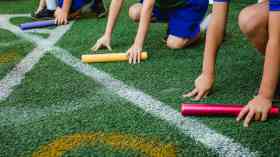A safe place to play – with an element of risk
 The past five years has seen significant investment in public parks and play areas and a substantial amount of this impetus was generated by the national play strategy launched by the government in 2008.
The past five years has seen significant investment in public parks and play areas and a substantial amount of this impetus was generated by the national play strategy launched by the government in 2008.
The ‘Playbuilder’ scheme injected over £235m into building, refurbishing and improving playgrounds around the country. The programme was supported by Play England and two inspirational documents were promoted. The first was ‘Managing Risk in Play Provision’ and the second, ‘Design for Play – a guide to creating successful play spaces’.
Both documents, particularly the first, promoted a revolution in attitude to children’s outdoor play and banished myths that play equipment should be so safe and prescriptive that children do not get an opportunity to learn about themselves. The second promotes natural play, it introduces managed risk and how to apply it to the design of play areas. It also describes how well designed play areas allow children to play creatively, while still experiencing an element of risk, in a challenging and exciting environment.
Risk assessment
‘Managing Risk in Play Provision’ is an implementation guide demonstrating how to carry out risk assessment to take into account the benefits of these challenging and exciting experiences. This gives confidence to those managing play areas, encouraging them to include apparently risky structures and stimulating equipment. This approach to risk can also be applied through other aspects of play, leisure and education.
Originally launched as a three year programme, a large proportion of the money allocated in the Playbuilder scheme was invested in playgrounds. This had a massive physical impact on both the number and type of play areas across the country. It also played a big part in influencing the attitude and thinking process with outdoor design. A significant part of the Playbuilder ethos was natural play. Natural play can mean being within a natural environment and playing with natural materials. It can also mean having an opportunity to use a piece of conventional play equipment within an artificial environment but in a more creative and unconventional way.
The architects
A landscape architect designing a play environment within a public open space today should meet two main criteria: to create something that is visually pleasing that makes the best use of the environment and landscape features that are available; to incorporate features and well-chosen equipment that offers best play value and will make that space inspiring to children and adults alike. This approach promotes outdoor play as it encourages adults to take younger children to outdoor community spaces and creates spaces that are ‘cool enough’ to be used by older children and young people.
The space itself should be flexible to allow play to develop and to constantly stretch children. Risk and excitement are important elements to include as they encourage children to push themselves and gives them opportunities to work together and to improve their skills in overcoming challenges.
Design improvements
There have also been many welcome improvements in the design of play equipment over recent years. Increased fall heights of up to 3m offer great excitement and are now acceptable as long as the appropriate impact surfaces are used. This may frighten parents and carers but it allows children to push their boundaries and experience risk that is unlikely to be on offer elsewhere. It is now widely acknowledged that allowing children to push themselves in a play in a carefully designed environment can prevent them from doing so in more dangerous, or even life threatening situations. Similarly, introducing high speed, dynamic, overhead swings encourage teenagers to play and enjoy themselves where previously playgrounds were deemed boring and uninteresting.
A good design will facilitate natural play. One way of doing this can be to provide natural materials and allowing children to ‘make their own’ fun. More conventionally, this can mean sand, often used as a play surface, but could also mean building materials such as wood. These both offer opportunities for children to make up their own rules, be creative and develop ideas.
Creating the environment for natural play within a school can be easier, particularly with the supply of props and loose materials. This can be extended to include a variety of items that inspire children into the world of make believe. This is less appropriate for older children but they too still need opportunities to play, which can be particularly difficult in restricted areas.
Physical activity
In working with many schools, one issue that is highlighted repeatedly is the lack of space, particularly within primary schools. This is made worse by the large differences in the ages of the children, which is reflected in their physical size, coordination skills and overall abilities. To continue to develop the culture of play and activity outside the school building, young people need to be provided with the opportunities for ‘free play’ alongside the important sports and games which offer more structure. They can learn to trust themselves and their environment in an already secure and managed environment.
Sports activities are part of the broader picture and must be encouraged as part of ‘free play’ for those who want to participate outside of the usual curricular activity. A recently published piece of research by University College London reported that just 51 per cent of the 6,500 children they monitored achieved the recommended hour of physical activity each day. For girls, the figure was just 38 per cent, compared with 63 per cent for boys. In 2007, Liverpool John Moores University also published its research into the behaviour of 10 and 11-year-olds in school playgrounds and identified that girls and boys play differently. Girls tend to spend their time talking in small groups and socialising. In contrast, boys were more likely to play in larger groups and to take part in games like football, which typically dominate a playground.
Space restrictions
It is important that schools encourage wider opportunities for more varied and inclusive sports as well as creating space for non-sports activities. Rather than stopping children playing sport it is better to avoid spatial conflict.
There are many recent examples where schools have been able to contain or segregate certain sports from the rest of the playground, which then allows the remainder of the children to play safely and without conflict.
The introduction of MUGAS and more recently Smooga’s, smart moveable multi‑use games areas, has helped schools provide discrete areas for sports of all kinds and are proving to be a huge asset where space is restricted. The feeling of more space can be created by clever compartmentalisation of activities, effectively getting more from less. Schools with too much space can also use these arenas for zoning, allowing smaller areas for football, hockey, handball or non-sports related activities, while other children can roam and play more freely in the other spaces.
It is not new to realise that schools have a role in teaching children to play and develop their confidence through this play. However, the way spaces are designed and the use of innovative products and ideas can all help facilitate the safe inclusion of children in all kinds of activities. Then when children experience the world outside school, they will be more aware of managing their own risk and more inclined towards a variety of play and activities.
Further information
carolyn@smooga.co.uk
www.smooga.co.uk
Latest News
27/11/2025 - 11:53
Ofqual has published revised statistics on access arrangements for GCSEs, AS and A levels, alongside new research into the role of time pressure in assessment.
26/11/2025 - 15:22
The announcement follows an earlier pledge of £10 million in funding to provide every primary school in England with a library by 2029.
26/11/2025 - 10:18
The Diets Toolkit recommends that governments introduce more plant-based options in schools, alongside hospitals and other public institutions,
25/11/2025 - 13:05
New data from The Careers & Enterprise Company (CEC) finds that around two-thirds of businesses believe a two-week block of work experience is too time-consuming and offers too little benefit.
25/11/2025 - 12:57
The Youth Sport Trust has launched its latest Class of 2035 Report, warning that unless urgent action is taken to increase physical activity among children, this generation will face poorer health and outcomes.







